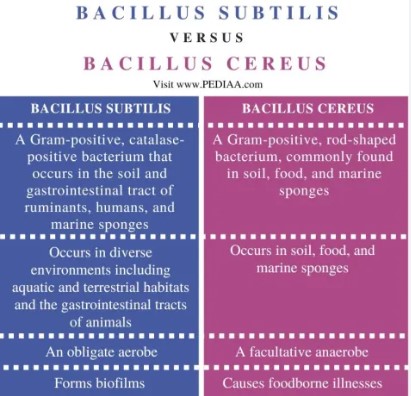Bacillus Subtilis and Bacillus Cereus are two distinct species of bacteria belonging to the genus Bacillus, which are widely studied for their diverse roles in the environment, industry, and health. Both organisms are rod-shaped, gram-positive bacteria, but their functions and impacts on human life are markedly different. This distinction is crucial for scientists, healthcare professionals, and industries that utilize these bacteria in various applications.
Bacillus Subtilis is generally recognized as safe and beneficial, used extensively in the fermentation industry and as a probiotic in human and animal diets. On the other hand, Bacillus Cereus is notorious for its role in food poisoning outbreaks, capable of producing toxins that cause severe illness. Understanding the fundamental differences between these two can aid in harnessing their benefits and mitigating their risks.
Both bacteria are found ubiquitously in the soil and have the ability to form spores, allowing them to survive in harsh conditions. This adaptability makes them subjects of interest in both biotechnological applications and medical studies. Their spore-forming capability is a key feature that not only contributes to their resilience but also poses unique challenges and opportunities in scientific research and industrial use.

Bacillus Subtilis Basics
Definition and Characteristics
Bacillus Subtilis, often referred to as the ‘hay bacillus’ or ‘grass bacillus’, is a rod-shaped, Gram-positive bacterium that is found predominantly in the soil and vegetation. It is an aerobic organism, meaning it requires oxygen to thrive, and is known for its ability to form a tough, protective endospore, allowing it to withstand extreme environmental conditions.
Characteristics of Bacillus Subtilis include:
- Endospore formation: This survival mechanism enables the bacteria to endure periods of nutrient deficiency and environmental stress.
- Motility: Equipped with flagella, Bacillus Subtilis can move in its environment, which is crucial for seeking nutrients and escaping toxins.
- Enzyme production: It secretes enzymes that break down complex molecules, aiding in decomposition and nutrient cycling in its habitats.
Common Applications
Bacillus Subtilis plays a vital role in various applications across different sectors:
- Agriculture: As a biofertilizer, it promotes plant growth by producing hormones and suppressing soil-borne diseases.
- Food industry: It is used in the fermentation of foods like natto, a traditional Japanese food made from soybeans.
- Medical field: Its ability to produce antibiotics makes it valuable in treating infectious diseases.
Bacillus Cereus Overview
Defining Traits
Bacillus Cereus is another rod-shaped, Gram-positive bacterium, but unlike Bacillus Subtilis, it is known for its pathogenic capabilities, particularly in food spoilage and poisoning. This bacterium is facultatively anaerobic, which allows it to thrive in both oxygen-rich and oxygen-poor environments.
Defining traits of Bacillus Cereus include:
- Toxin production: It can produce toxins that cause vomiting and diarrhea, which are the primary symptoms of foodborne illness linked to this bacterium.
- Sporulation: Similar to Bacillus Subtilis, Bacillus Cereus can form spores, which contribute to its persistence in the environment and resistance to cooking and disinfection processes.
Key Uses and Risks
While Bacillus Cereus is predominantly known for its risks in food safety, it also has beneficial uses:
- Bioremediation: It can degrade hydrocarbons and is used in cleaning up oil spills.
- Enzyme production: Useful in industrial applications for the synthesis of starches and other materials.
The risks associated with Bacillus Cereus primarily revolve around food safety:
- Food poisoning: Improperly stored or cooked foods can lead to Bacillus Cereus contamination.
- Cross-contamination: It can survive cooking temperatures, making it a concern in kitchens and food processing areas.
Genetic Differences
Comparative Genomics
Comparative genomics of Bacillus Subtilis and Bacillus Cereus reveals significant genetic differences that explain their divergent roles in nature and industry. While both share a common Bacillus lineage, their genomes have evolved to equip them with different survival strategies and capabilities.
Key Genetic Markers
Key genetic markers differentiate Bacillus Subtilis and Bacillus Cereus:
- PlcR regulon: Bacillus Cereus possesses this regulatory system controlling virulence and toxin production, absent in Bacillus Subtilis.
- Antibiotic genes: Bacillus Subtilis has genes that produce a range of antibiotics, which are not as prevalent in Bacillus Cereus.
Physiological Contrasts
Growth Conditions
The optimal growth conditions for these bacteria vary:
- Bacillus Subtilis thrives best at temperatures between 25-35°C and in oxygen-rich environments.
- Bacillus Cereus favors slightly higher temperatures and can grow under both aerobic and anaerobic conditions.
Metabolic Capabilities
Their metabolic capabilities also differ significantly:
- Bacillus Subtilis is noted for its robust enzymatic activity that aids in decomposing organic matter.
- Bacillus Cereus focuses more on toxin production which impacts its role in food-related environments.

Implications in Health
Beneficial Aspects of Bacillus Subtilis
Bacillus Subtilis is renowned for its positive impact on health, particularly through its probiotic properties. The use of Bacillus Subtilis as a probiotic has been shown to offer several health benefits:
- Digestive health: It helps in restoring the balance of gut flora, aiding in digestion and preventing gastrointestinal disorders.
- Immune system support: By enhancing the immune response, Bacillus Subtilis can help the body fight off infections more effectively.
- Antibiotic properties: It produces substances that have antibiotic effects, which can be used to treat skin infections, and suppress harmful bacteria.
Health Risks of Bacillus Cereus
Contrarily, Bacillus Cereus poses significant health risks due to its toxin-producing ability. The primary concerns include:
- Food poisoning: The toxins produced by Bacillus Cereus can lead to severe nausea, vomiting, and diarrhea, often manifesting within hours of consuming contaminated food.
- Opportunistic infections: In immunocompromised individuals, Bacillus Cereus can cause invasive infections, which can be difficult to treat due to resistance to common antibiotics.
Industrial and Commercial Uses
Bacillus Subtilis in Products
The versatility of Bacillus Subtilis extends to various industrial and commercial applications:
- Enzyme production: It is used in the manufacture of enzymes for laundry detergents and other cleaning agents.
- Agricultural products: As a biopesticide, Bacillus Subtilis is effective in protecting crops from fungal and bacterial diseases without the harmful side effects associated with chemical pesticides.
Bacillus Cereus in Industries
Although primarily known for its negative effects, Bacillus Cereus has useful applications in certain industrial contexts:
- Biodegradation: It is employed in the biodegradation of hydrocarbons, helping to clean up oil spills and other environmental contaminants.
- Phytase production: Bacillus Cereus produces phytase, an enzyme used in animal feed to improve nutrition absorption by breaking down phytic acid in grains.
Safety and Handling
Laboratory Safety
Handling Bacillus species in the laboratory requires strict safety protocols to prevent contamination and ensure the safety of lab personnel:
- Sterilization and disinfection: Proper sterilization of equipment and use of disinfectants are essential to prevent the spread of Bacillus spores.
- Personal protective equipment (PPE): Lab coats, gloves, and safety goggles are mandatory when handling cultures of Bacillus species.
Industry Best Practices
In industries that utilize Bacillus bacteria, adhering to best practices is crucial for both efficacy and safety:
- Quality control: Regular testing for contamination and effectiveness ensures that products meet safety standards.
- Training and awareness: Employees must be trained on the specific characteristics and handling procedures of Bacillus to avoid mishaps and ensure proper use.
Future Research Directions
Potential Studies
The potential for future research into Bacillus Subtilis and Bacillus Cereus is vast, with several areas ripe for exploration:
- Genetic engineering: Enhancing the beneficial traits of Bacillus Subtilis and mitigating the risks associated with Bacillus Cereus through genetic modifications.
- Drug development: Utilizing the antibiotic properties of Bacillus Subtilis to develop new treatments for bacterial infections.
Emerging Applications
Emerging applications of these bacteria are being identified in new sectors:
- Nano-biotechnology: Bacillus spores are being studied for their potential use in nanotechnology applications, such as targeted drug delivery systems.
- Waste management: Both species are being explored for their ability to break down organic waste, contributing to more sustainable waste management practices.
Frequently Asked Questions
What is Bacillus Subtilis?
Bacillus Subtilis is a bacterium found in soil and the gastrointestinal tract of humans and animals. It is known for its ability to form protective endospores and its wide use in the fermentation industry due to its safety and beneficial properties.
How does Bacillus Cereus affect health?
Bacillus Cereus is primarily associated with foodborne illnesses. It produces toxins that can cause vomiting and diarrhea shortly after ingestion of contaminated food. Proper food handling and cooking are essential to prevent infections.
Can Bacillus Subtilis improve digestive health?
Yes, Bacillus Subtilis is often used as a probiotic supplement to promote digestive health. It can enhance gut flora, improve digestion, and boost the immune system by competing against pathogenic bacteria in the digestive tract.
What are the industrial uses of Bacillus Cereus?
Despite its pathogenicity, Bacillus Cereus is utilized in certain biotechnological processes. It is studied for its ability to produce enzymes and other bioactive compounds that are useful in industrial applications.
How can one differentiate between Bacillus Subtilis and Bacillus Cereus?
Differentiating these two bacteria can be achieved through genetic and biochemical testing. Key differences include their ability to metabolize various sugars and their reaction to specific chemical tests.
Conclusion
In conclusion, Bacillus Subtilis and Bacillus Cereus serve as fascinating examples of how closely related bacteria can evolve to occupy very different ecological niches and roles. Bacillus Subtilis is celebrated for its beneficial uses, particularly in health and industry, whereas Bacillus Cereus poses significant challenges due to its association with foodborne illnesses.
Understanding these bacteria is essential not just for scientific and medical communities but also for the general public, especially in terms of food safety and the beneficial applications of probiotics. Future research and technological advancements will likely further harness the capabilities of these microorganisms, emphasizing the importance of ongoing studies and vigilance in managing the risks associated with Bacillus Cereus.

